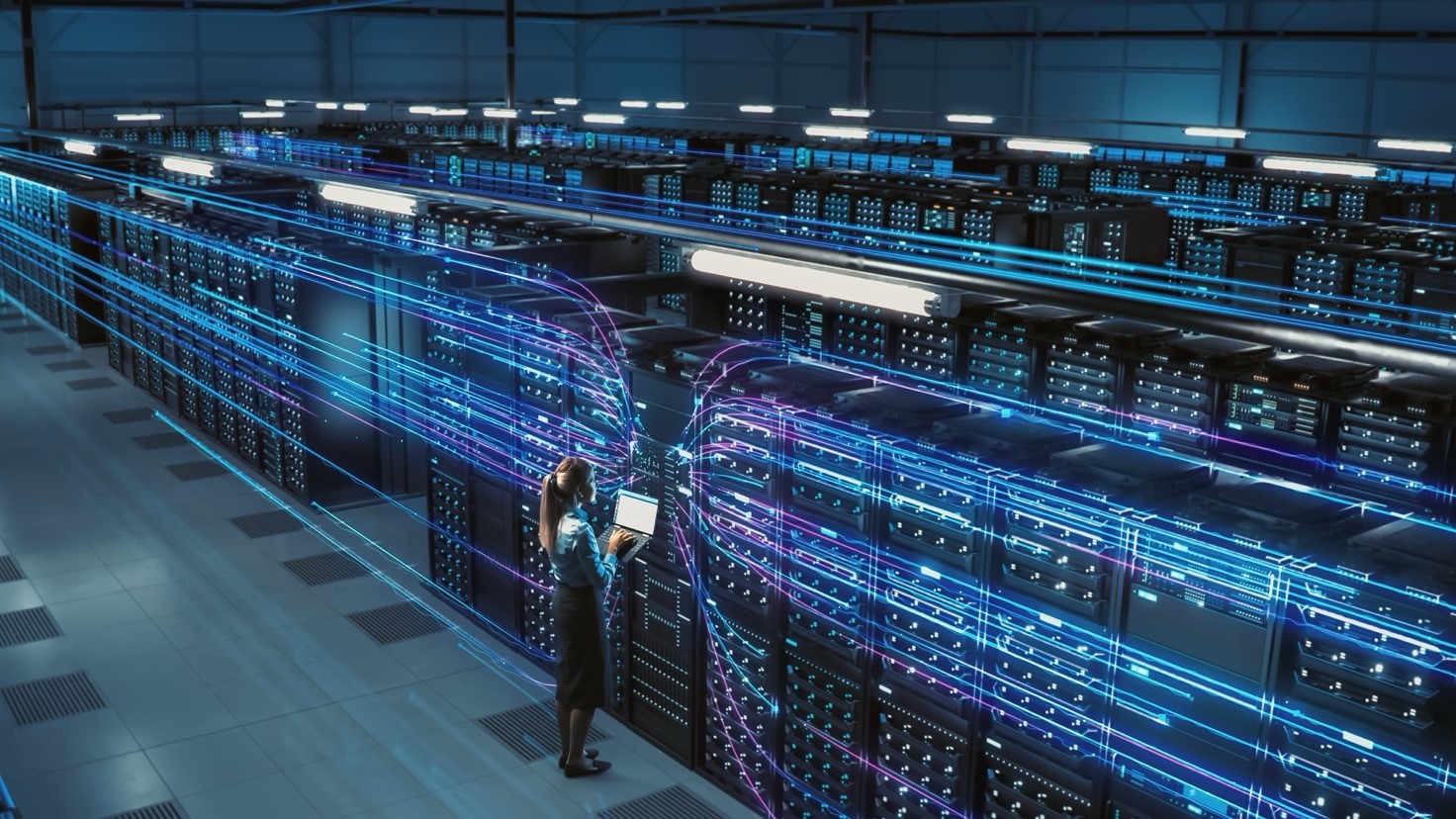Data center has always been considered as a bunker for statistics data, meaning a place to collect and store necessary data to work on company’s information. Over the years, it has taken on a different meaning: it is, now, defined as IT infrastructure backbone for processing and analyzing information, like AI, Machine Learning or Internet of Things. As the global economy has rapidly digitalized, companies have started cooperating with international partners by sharing information in a private, straight forward, safe, and fast way. The number of available data has significantly multiplied as well as the need of implementing ecosystems to access shared information. This is possible within data centers, whose role has gained unprecedented importance.
2023: a prosperous year for Italian Data Centers
According to research from Data Center Observatory, promoted by Politecnico di Milano School of Management, last year Italian Data Centers registered an unprecedented growth: 23 organizations (including 8 new companies entering the Italian market) announced the opening of 83 new infrastructures between 2023-2025, whose deployment might potentially bring up to 15 billion euros of total investments. These new infrastructures led to a growth of 80 MW in active nominal power, bringing the total power of Italian data centers to 430 MW (+23% compared to 2022). Colocation segment, meaning the buying, selling and rental of dedicated infrastructures for placing servers and companies’ data, is growing as well. Last year, this segment reached a value of 654 million euros (+ 10% compared to 2022). Should market conditions be favorable, it is believed that this capacity could double by next year. This specific value is further increased by an even more significant impact related to the digital markets for these infrastructures. The average power of the most part of Italian data centers is 2-10 MW and <2MW for less powerful ones, while buildings with high power (>10 MW) are less common. The latter are more complex to build, and they are bound by the presence of high-voltage connection points.
According to data from the Data Center Observatory of Politecnico di Milano, Milan represents the country’s leading infrastructure hub (184 MW). Although still far from a reference hub like Frankfurt (791 MW), Milan is being considered as one of the most interesting centers in the European Data Center ecosystem compared to other emerging countries such as Madrid (136 MW) and Warsaw (86 MW). Rome is also beginning to get a prominent role and could potentially become the country’s second hub, albeit on a much smaller scale. Quite the opposite for less widespread Italian infrastructures. This development, both at regional and national level, is catching on in a constantly evolving European scenario where data centers have been historically concentrated in 5 main cities: Frankfurt, London, Amsterdam, Paris, Dublin. Nonetheless, after many years of relentless growth, the development of these cities is slowing down creating new opportunities for other countries. Furthermore, the development of European cloud ecosystem is moving towards a decentralized approach: this happens because, from a functioning point of view, the building of edge computing infrastructures aims to reduce network latency. Policy represents another key driver as the development of local data centers is aimed at storing and securing sensitive data both for strategic and safety reasons. The Italian government, with the National Recovery and Resilience Plan and the digital transformation process in the public administration, is optimizing its own infrastructures creating a strategic national hub to face critical situations.
 National Strategic Hub paves the way for Italian cloud platforms
National Strategic Hub paves the way for Italian cloud platforms
The National Strategic Hub (PSN) is a new cloud platform for country’s public administration bodies promoted by TIM, Leonardo, CDP (through CDP Equity) and Sogei which provides Public Administration with a secure, efficient, and reliable could infrastructures. The new hub is one of the main pillars of Italian Could Strategy, a digital transformation project aiming at brining country’s administrations to use cloud-based services in three main types of services: classification of data and services (strategic, critical and ordinary) identification of those transferable to the cloud, and effective migration towards the National Strategic Hub. National Recovery and Italian and European Resilience Plan’s milestones are expected to migrate 30 administrative bodies by September 2023, to migrate 100 by the end of this year and to migrate 280 by 2026. At the core of the Strategic Hub we can find four data centers, respectively two in Lombardy and two in Lazio to ensure data back-up, recovery disaster and continuous management, even in case of crisis. The main sites of the above-mentioned Data Centers have been identified in Acilia, Pomezia, Rozzano and Santo Stefano Ticino.
Data Centers are built in compliance with the highest sectors requirements, and they have the most important audits to be able to provide the necessary power usage efficiency while ensuring excellence in management and operational processes. According to the planned guidelines by National Recovery and Resilience Plan, 280 administrative bodies are getting ready to migrate to cloud computing, including main administrations and health companies. The first milestone entails the migration of the first 100 administrations by September 2024: the digital transformation process is exceeding the expectations; Government’s NRRP is launching a high reliable cloud infrastructure able to help administrative bodies face the transition. People personal data will be stored in local Data Centers and will be monitored 24/7 through specific cybernetic systems.
Data Centers are spreading all over Europe
In 2023, the market of data centers reached 18 billion dollars, equal to a yearly growth rate of 13%. According to ReserachAndMartets.com the implementation and use of cloud-based data, both from companies and users, will lead tech giants such as Meta, Google, Amazon Web Services and Microsoft to create new data centers all over Europe. The increasing use of these services in Europe will further develop data center colocation market in the years to come. Germany holds the largest market share thanks to digital transformation strategies, cloud computing, IoT, AI, Gdpr implementation and measures taken soon after the pandemic. In United Kingdom, London is one of the main venues for investments while some other cities, like Manchester, Slough and Birmingham, expect significant investments in the next years. Retail and wholesale colocation are the two segments under consideration, with the first one holding the highest market share. This segment is expected to grow at the highest CAGR in the coming years, as it offers flexibility in terms of IT infrastructure, benefiting small and medium-sized enterprises. Large enterprises hold the largest share of the data center market. The market expansion is driven by the increasing adoption of colocation services by major cloud service providers and hyperscale.
 2024 challenges and focus on sustainability
2024 challenges and focus on sustainability
After the growth in 2023, Data Centers will have to face a series of challenges in the coming months: the main challenge is represented by the sustainable management. According to Uptime Institute think tank data, next year many cloud providers will have to step back on their goals mainly because, in terms of sustainability efforts, they are struggling to keep pace with new regulations. Environmental and energy sustainability are key issues on the table emerging from the analysis conducted by the Uptime Institute on the data center system. This analysis highlights the underlying trends that will influence the growth and development of the digital infrastructure sector throughout 2024. More specifically, according to the Institute, 2024 will be such a demanding and challenging time for data centers which will last till 2030. The analysis highlight that, over these years, companies will strive to “reaching sustainability goals and reporting requirements while facing regulatory bodies and partners, trying to adjust their business goals to match the sustainability ones.” For operators will be harder to meet their sustainability commitments and, at the same time, work towards achieving their publicly declared zero-emission goals. It means that some players might either review their goals or become clearer and more transparent about the ongoing progresses. The most straight forward path to be pursued would be to further increase investments.
However, the analysis warns that achieving stricter public targets will not be easy for those managing critical infrastructures. On the other hand, many activities run in Data Centers have a significantly high energy consumption coefficient. According to the think tank: “a greater use of energy system management software, the lack of renewable energy in power grids and the increasing requirements to the ongoing climate change will make it harder to reduce carbon emissions.” At the same time, stakeholders’ pressure on being compliant to regulations might lead companies to resort to more efficient strategies encouraging for progressive and efficient investments.” Other than abiding by public regulations concerning carbon emissions, in 2024 cloud providers should confront four macro-trends. The first one concerns AI impact which has forced data centers to address an unprecedented demand and need for energy and colling. Even though data centers will be significantly impacted by AI, the most demanding services will be provided by different players. For most operators, the impact will be indirect: hence, the immediate challenge will therefore be to find the best approach to offer a different mix of density and resilience levels within the same structure. The analysis explains how operators have been slow to leverage advancements in software, connectivity, and sensor technologies that can help optimize and automate the operation of critical infrastructures. “The national scenario is evolving as it involves lots of operators who have been practicing new software and AI platforms.” However, the current landscape portrays a sector still evolving and exposed to risks associated with complexity, poor implementation, and tool selection.
The issue of energy efficiency is also on the table: operators have high expectations for liquid direct cooling in terms of improving efficiency and sustainability. However, these advantages will be out of reach for many organizations. According to the report, the slow introduction of this technology—characterized by mixed environments, limited optimization, and the ongoing need to operate existing systems in parallel—will limit its contribution to infrastructure efficiency, despite its strong need.
The construction of new hyperscale colocation campuses, connected by high-bandwidth fiber, will eventually ease the pressure on traditional data center hotspots and, in the long term, lower colocation prices. As a solution to the soaring demand for computing and storage, the hyperscale campus will gradually emerge, with the availability of fiber and power being critical factors.
 Final thoughts
Final thoughts
There is no doubt that the Data Center sector has experienced rapid development in recent months and continues to show significant growth potential. All recent studies point in this direction, indicating that the Italian market is a promising one in terms of growth and development potential.
However, there are two issues: addressing the sustainability challenges in a high-energy consumption sector and complying with the regulatory constraints imposed by individual national governments. Greater investment seems to be the obvious path forward. However, alongside the increasing need of resources to adopt the most innovative technological solutions, there must also be a strategic vision, including public policies, that can guide and support the development of this sector, which is critical for the growth of the ‘Country System’.





